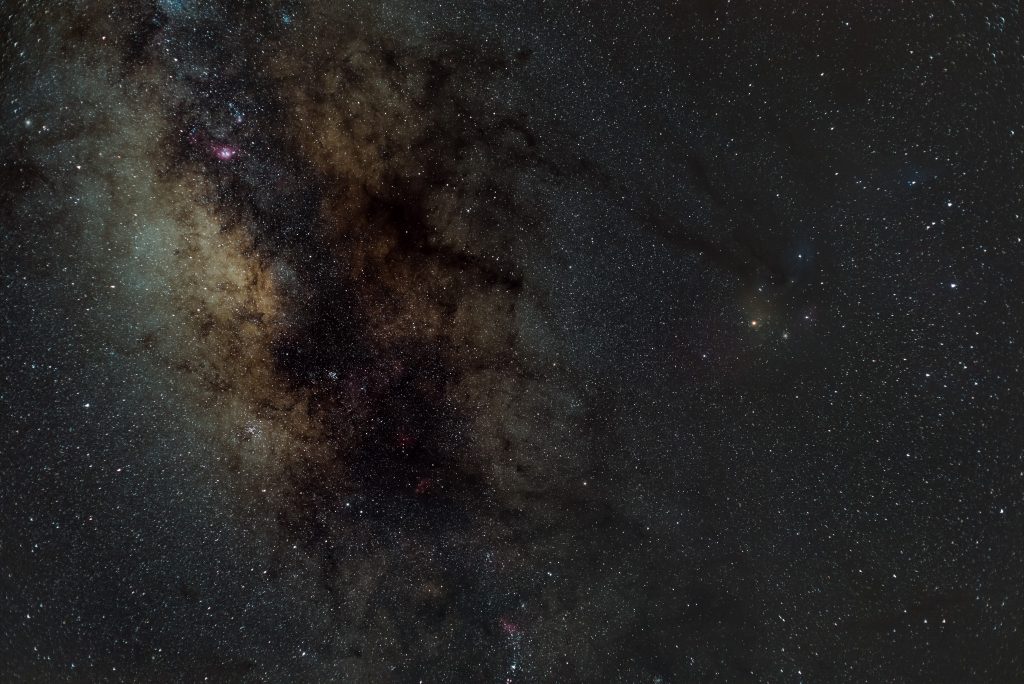This year was a special year. The pandemic outbreak ruined my first attempt of chasing the darkness on the Canary Islands in May. I didn’t give up and as soon the restrictions were released, I purchased plane tickets to Fuerteventura again. We rented a house via AirBnB on the south side of the island, in the middle of nowhere, where the light pollution was minimal (measured SQM 21.2).
The island lies on the 28th parallel, which makes the core of the Milky Way pretty up in the sky. And this was exactly my primary astrophotographic target. I packed recently astro-modified Canon 6D, nifty-fifty 50 mm f1.8 lens and headed south. The aim was to capture the Antares region together with the core of the Milky Way and in the end, I somehow managed. However, the lens disappointed me a lot, because it suffers from comatic and chromatic aberrations, combined with astigmatism. The stars in the corners are not round, even if the lens is slowed down to f 3.5. I was trying nearly every evening to recapture the Milky Way, but I was fighting with the weather (it was very windy) and with the equipment (polar alignment, shutter release, drained batteries), but I somehow managed to generate at least one decent picture of the desired target. Lessons learned – I need a better 50 mm lens.

Technical details:
| Lens | Canon EF 50 mm f1.8 |
| F-stop | 2.8 |
| Focal length | 50 mm |
| Mount | Baader NanoTracker |
| Camera | Canon EOS 6D Astro modified |
| Exposure | 14x20s, ISO 1600 |
| Date | 2020-07-22 |
I also packed 150mm Newtonian, together with my new mount Rainbow Astro RS135. This mount is simply excellent and very portable. I still have Avalon M-Zero, but it is significantly heavier, therefore if I travel with Avalon, I have to order a second suitcase and to travel with two suitcases is not that convenient. Rainbow Astro occupies only half of my luggage, so there was a space for some T-shirts. I must say, that the Avalon is a better mount for tracking and there is no need to do a meridian flip, but the portability is for me more important. The primary target was the Lobster nebula, but I managed to capture some DSOs around Antares and in the core of the Milky Way (Lagoon, Trifid, M4, M6, M7, M24, IC4304).

The conclusion: the weather was much better than in La Palma last year. Every night was cloudless, but it was windy. Fortunately not every day, so in the end, it was a quite successful trip.

[…] picture was taken under dark skies of Fuerteventura and it’s a stack of 73 pictures, 3 minutes each, which makes total integration time 219 […]
[…] Grease was constantly disturbed by the weather, therefore we I was again in South, specifically at Fuerteventura, I didn’t hesitate and recapture this beautiful […]
[…] Messier 4 (left side of the picture) is a globular cluster located in constellation Scorpius, close to the brightest star of this constellation Antares (right side). This cluster is the closest one to the Solar System, due to its “short” distance 7200 light-years and it contains several tens of thousands of stars. There is another globular cluster on the bottom side of the picture NGC 6144. The star Antares is classified as a red supergiant, with diameter several times bigger than the Sun, which makes it one of the largest know stars. it is only 550 light-years away, which means M4 and Antares are close only visually, but in reality, there is a very long distance between them.If any brighter star is photographed by the Newtonian telescope, the diffraction cross appears due to the so-called “spider vanes” holder of the secondary mirror. If the spider vanes are not perpendicular to each other (like in my case), the diffraction pattern makes multiple ugly lines. This means I will have to correct it, as soon as I get back from Fuerteventura. […]
[…] signal to noise ratio can be significantly improved. I purchased Baader Nano tracker for my trip to Fuerteventura, but I was struggling with the equipment (shutter release, polar alignment, and lens) and as soon I […]
[…] Messier 24 is a spiral arm of our galaxy located in the constellation Sagittarius. The region is heavily populated by the stars, which makes you think how big our home galaxy Milky Way is. I captured it already a few years back, but it would be a pity not to recapture this magnificent star cloud again with a slightly shorter focal length and under the dark skies of Fuerteventura. […]
[…] These two magnificent nebulae are located visually close to each other in the constellation Sagittarius. This means we are looking in direction of the galactic core of the Milky Way. Trifid Nebula (up left) is a combination of a reflection nebula (blue part), a dark nebula (brown clouds), an emission nebula (red part), and a star cluster. On the other hand, the Lagoon nebula (right side) is an emission nebula – a giant cloud of ionized HII gas. Due to very low southern declination, it’s very difficult to photograph these deep space objects from my home place in Central Europe. Therefore every time I travel south, I take the opportunity and recapture these nebulae. My first attempt of M20 was done with focal length 917 mm, the second one with 630 mm and now I used a gentle focal reducer. Focal length 570 mm allowed me to fit both nebulae into the field of view of APS-C sensor size. The picture is an integration of 213 minutes, taken under the dark skies of Fuerteventura. […]